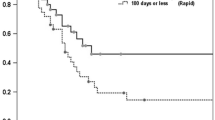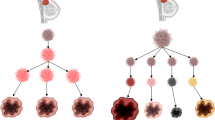Abstract
The volume doubling time (T2) of 52 lung metastases in 21 patients was calculated from measurements done on plain chest radiographs. Follow-up times ranged from 14 to 819 days. The measurements were fairly well reproducible in the majority of patients, although considerable discrepancies in T2 estimates made by two independent observers were found in a few patients. The median doubling time was 34.9 days (estimated 95% range 3.9 to 352 days). The variation of T2:s between patients was significantly (P = 0.0001) larger than that between T2: of multiple metastases in the same patients. The growth of the metastases seemed to be well described by a simple exponential function in all patients with more than two measurements, without evidence of Gompertzian growth. There seemed to be a linear correlation between the logarithm of T2 and log-survival time from diagnosis of metastatic disease, even if only one third of the variation of survival times between patients could be explained by differences in T2. T2 was not a significant factor for survival in Cox-analysis (P = 0.10).
Similar content being viewed by others
Author information
Authors and Affiliations
Rights and permissions
About this article
Cite this article
Blomqvist, C., Wiklund, T., Tarkkanen, M. et al. Measurement of growth rate of lung metastases in 21 patients with bone or soft-tissue sarcoma. Br J Cancer 68, 414–417 (1993). https://doi.org/10.1038/bjc.1993.351
Issue Date:
DOI: https://doi.org/10.1038/bjc.1993.351
- Springer Nature Limited
This article is cited by
-
Evaluation of the stability and intratumoral delivery of foreign transgenes encoded by an oncolytic Foamy Virus vector
Cancer Gene Therapy (2022)
-
(Neo)adjuvant chemotherapy and interdigitated split-course hyperfractionated radiation in high risk soft tissue sarcoma – Results from a large single-institution series
Scientific Reports (2019)
-
Clinical impact of the tumor volume doubling time on sarcoma patients with lung metastases
Clinical & Experimental Metastasis (2011)




